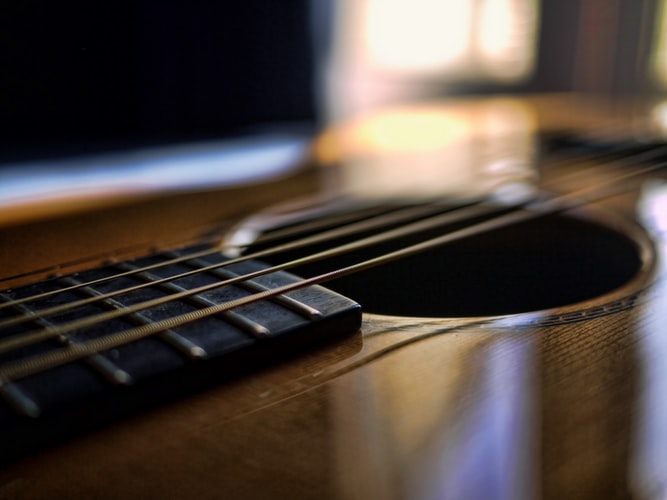One of the biggest pains for beginners is to pick up a guitar, play a chord, and not have it sound like you wanted it to. Most times, this is as a result of distuned strings. So today we are going to teach you how to tune an acoustic guitar.

There are three main ways you can tune your acoustic guitar. The first way is by ear, the second way is using a clip-on tuner, and the third is by using smartphone applications or other online tuning applications.
Table of Contents
Tuning By Ear
This is the most affordable way to tune your guitar. However, it’s not the easiest or fastest. It takes a lot of time and patience to get it right. But on the bright side, the only thing you need is your ear, well partially.
Tuning The Low E String (6th String)
To tune your acoustic guitar by ear, the low E string would need to be tuned first. The easiest way to do this is to have a keyboard nearby play the low E note. You should then continue playing the open string while turning the tuning peg attached to that string.
Keep doing this until the sound you hear from the open string matches the low E note from the keyboard perfectly. Once this happens, you’ve successfully tuned the low E string. It’s important you do this first as that would be the basis for tuning the other strings.
If you do not have a keyboard nearby, click the video below for the sound of the low E string. Match the sound you hear to the low E string as we’ve explained above.
Tuning The A, D, and G Strings (5th To 3rd Strings)
Once you’ve tuned the 6th string, it’s time to move on to the 5th, which is the A string. To tune the A string, you’ll need to go to the fifth fret of the low E string and play that note.
That’s your A note. Since the open 5th string is an A note, it should sound exactly the same as the A note on the 5th fret of the low E string.
Now that you’ve tuned the 5th string, repeat the same process for the 4th and the 3rd string.
The 5th fret of 5th string is the same as the open 4th string. Both of them are D notes.
The 5th fret of the 4th string is the same as the open 3rd string. Both of them are G notes.
Tuning The B and High E Strings (2nd And 1st Strings)
The B string, the 2nd string, is a little different from the other strings. With the standard acoustic guitar tuning, it is the 4th fret on the G string that houses the B note, not the fifth fret, like the rest.
So, instead of matching the open B string to the fifth fret of the G string, you’ll need to match it to the fourth fret.
The first string goes back to standard tuning. So, the fifth fret on the B string will give you the High E note, which is the same as the open first string.
Once you’re done tuning, go through all the strings again, making sure that they are tuned accordingly. This way, you can make all the necessary adjustments and ensure that the strings are completely in tune.
When double-checking, a huge tip is to play some chords as you would normally. Sometimes, playing a single note does not allow you to hear all the tiny details and differences properly. So by playing full chords, you can hear the problems in the tuning and make changes accordingly.
Tuning With A Clip-on Tuner
A guitar tuner is basically a device used to detect the pitch of the open strings on your guitar. It then displays this pitch for you on a small LCD or LED display, showing you whether your open string is higher, equal to, or lower than the required pitch.

To tune with a guitar tuner, you need to actually get the tuner first. The tuner we often suggest is the Snark SN5X Clip-On Tuner. It’s extremely affordable, basic, and works well. It’s also a bestseller, just to tell you how good it is.
If you already have a tuner that’s not the one we mentioned, not to worry. Most guitar tuners have the same basic functionalities and only differ slightly from one another.
We’re sure you already know what the names of the strings on your guitar are. If you don’t, then check out our article on “What Notes Are The Guitar Strings?” as you would need that knowledge to properly tune your guitar with a tuner.
With the knowledge of the names of the strings, you can then clip your tuner on to your guitar and pluck on the 6th string, the low E string. You should see the note show up on the display of the tuner. Turn your tuning peg either upwards or downwards until the note that shows up on the screen changes color (it’s usually from red to green).
Repeat the same step for all the remaining strings as the corresponding note pops up on the tuner.
Quite an easy process right? However, if you still don’t understand this process, we suggest you watch the video below to help you visualize it better.
Tuning With Smartphone Apps And Online Tuners
This method is very similar to using a clip-on tuner. The only difference is that the clip-on tuner measures the vibrations of the string to determine its pitch.
On the other hand, these smartphone and online applications make use of the actual sound from plucking each string, so you would have to be loud so it can register it.
The app we recommend the most for tuning is the Fender Tuning App. It’s is very basic, easy to use, and best of all, it’s completely free. Watch the video below for a complete demonstration on how to tune your acoustic guitar using Fender Tune.

Conclusion
There are a lot of other methods you can use to tune your guitar. However, the three mentioned in this article are the easiest, the most affordable, and generally the most popular ways to tune your acoustic guitar.
Also note, that the tuning we talked about throughout this article is called “Standard Tuning”. That is tuning the guitar to the standard “E – B – G – D – A -E”, from the 1st to the 6th string.
There are many other ways to tune your guitar and you can even come up with your own unique tuning. However, for beginners and most intermediate players, the standard tuning is all you need to know.
